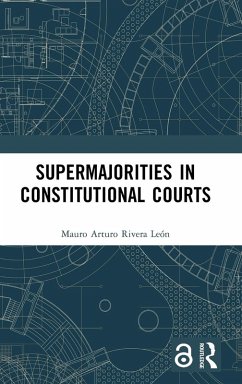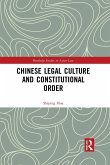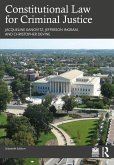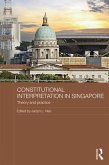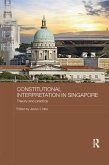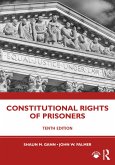Mauro Arturo Rivera León
Supermajorities in Constitutional Courts
Mauro Arturo Rivera León
Supermajorities in Constitutional Courts
- Gebundenes Buch
- Merkliste
- Auf die Merkliste
- Bewerten Bewerten
- Teilen
- Produkt teilen
- Produkterinnerung
- Produkterinnerung
This book explores systems employing supermajorities in constitutional adjudication by performing a comparative analysis of ten jurisdictions and twelve supermajority models. It introduces a typology of the main models of institutional design, the reasons leading policymakers to establish them, and the impact supermajorities have on courts.
Andere Kunden interessierten sich auch für
![Chinese Legal Culture and Constitutional Order Chinese Legal Culture and Constitutional Order]() Shiping HuaChinese Legal Culture and Constitutional Order58,99 €
Shiping HuaChinese Legal Culture and Constitutional Order58,99 €![Constitutional Law for Criminal Justice Constitutional Law for Criminal Justice]() Jacqueline R. KanovitzConstitutional Law for Criminal Justice334,99 €
Jacqueline R. KanovitzConstitutional Law for Criminal Justice334,99 €![Constitutional Interpretation in Singapore Constitutional Interpretation in Singapore]() Constitutional Interpretation in Singapore191,99 €
Constitutional Interpretation in Singapore191,99 €![Constitutional History of the UK Constitutional History of the UK]() Ann LyonConstitutional History of the UK191,99 €
Ann LyonConstitutional History of the UK191,99 €![Constitutional Interpretation in Singapore Constitutional Interpretation in Singapore]() Constitutional Interpretation in Singapore73,99 €
Constitutional Interpretation in Singapore73,99 €![Engineering Constitutional Change Engineering Constitutional Change]() Engineering Constitutional Change68,99 €
Engineering Constitutional Change68,99 €![Constitutional Rights of Prisoners Constitutional Rights of Prisoners]() Shaun M. GannConstitutional Rights of Prisoners140,99 €
Shaun M. GannConstitutional Rights of Prisoners140,99 €-
-
-
This book explores systems employing supermajorities in constitutional adjudication by performing a comparative analysis of ten jurisdictions and twelve supermajority models. It introduces a typology of the main models of institutional design, the reasons leading policymakers to establish them, and the impact supermajorities have on courts.
Produktdetails
- Produktdetails
- Verlag: Routledge
- Seitenzahl: 258
- Erscheinungstermin: 5. April 2024
- Englisch
- Abmessung: 240mm x 161mm x 19mm
- Gewicht: 555g
- ISBN-13: 9781032599694
- ISBN-10: 1032599693
- Artikelnr.: 70146326
- Herstellerkennzeichnung
- Libri GmbH
- Europaallee 1
- 36244 Bad Hersfeld
- gpsr@libri.de
- Verlag: Routledge
- Seitenzahl: 258
- Erscheinungstermin: 5. April 2024
- Englisch
- Abmessung: 240mm x 161mm x 19mm
- Gewicht: 555g
- ISBN-13: 9781032599694
- ISBN-10: 1032599693
- Artikelnr.: 70146326
- Herstellerkennzeichnung
- Libri GmbH
- Europaallee 1
- 36244 Bad Hersfeld
- gpsr@libri.de
Mauro Arturo Rivera León is Assistant Professor at the University of Silesia in Katowice, Poland. From 2023 to 2024 he lead the Research Project "Qualified majorities in counter-majoritarian mechanisms: Towards a new theory of supermajorities in judicial review" funded by the Norwegian Financial Mechanism 2014-2021. He obtained his PhD at the Complutense University in Madrid, Spain. Dr. Rivera has been visiting researcher at the Max Planck Institute for Comparative Public Law and International Law in Heidelberg, Germany, the Perelman Center for Philosophy of Law at the Free University of Brussels, Belgium. He is a member of the National System of Quality Researchers in Mexico (CONAHCYT-SNI), level II (senior researcher). He is the author of six books, including four legal research monographs and more than fifty scientific papers/book chapters in Spanish, English, and Polish. He has received seven national prizes for his research.
Acknowledgments xii
PART I
THEORY OF SUPERMAJORITIES 1
1 Introduction 3
1.1 Why Supermajorities? 3
1.2 Scope of the Book 4
1.3 Overview of the Main Arguments and Approach 6
1.4 Plan of the Book 8
2 Voting Protocols and Supermajorities: A Conceptual Introduction 10
2.1 Voting Protocols in Constitutional Adjudication 10
2.1.1 Introduction 10
2.1.2 Types of Decision-Making Thresholds 12
2.1.3 Quorums and Majorities 16
2.2 A Brief History of the Discussion on Supermajorities in Constitutional
Adjudication 17
2.2.1 The Birth of a Debate 17
2.2.2 The Debate in the Scholarship 21
2.3 Looking Ahead 27
PART II
SUPERMAJORITIES IN PRACTICE 29
3 Historical Supermajorities 31
3.1 The United States Subnational Supermajorities: The Birth of
Supermajorities 31
3.1.1 The First Supermajority: From Rebellion to Extinction in Ohio's
Supreme Court (1912-1968) 32
3.1.1.1 Constitutional Convention Deliberations: Unraveling the
Supermajority Debate 34
3.1.1.2 The Supermajority and Ohio's Supreme Court: The Sabotage Campaign
36
3.1.1.3 Practice and Demise 38
3.1.2 North Dakota: A Nonpartisan Supermajority (1919-Present) 42
3.1.2.1 The NPL and the Supermajority's Adoption 42
3.1.2.2 The Rule's Functioning 45
3.1.2.3 Assessing the Rule's Success 52
3.1.3 Nebraska (1920-Present) 54
3.1.3.1 Constitutional Convention Discussion in Nebraska 54
3.1.3.2 The Rule's Practice 57
3.1.3.3 Surviving Reform: An Assessment of the Supermajority 62
3.2 The Supermajority in the World's First Constitutional Court:
Czechoslovakia (1920-1938) 64
3.2.1 Introducing a Supermajority 66
3.2.2 The Rule's Functioning 68
3.2.3 Demise and Assessment of the Rule 72
3.3 What Does History Teach Us? 74
4 Contemporary Supermajorities 75
4.1 Peru: A Jurisdiction of Many Supermajorities (1963, 1982, 1995, and
2002) 75
4.1.1 The Supermajority in the Tribunal of Constitutional Guarantees
(1982-1992) 76
4.1.2 The Fujimorists' Supermajority 81
4.1.3 The Supermajority in Peru's Contemporary History 87
4.1.3.1 The Birth of a New Supermajority 87
4.1.3.2 Practice of the Contemporary Supermajority 88
4.1.3.3 Expansion of Supermajority Rules by the Constitutional Court 93
4.2 The Supermajority in the Contemporary Czech Constitutional Court
(1993-Present) 96
4.2.1 Czechoslovakia's Heritage: The Resurrection of the Supermajority 98
4.2.2 The Supermajority in Practice 99
4.2.3 Assessing the "Silent" Supermajority 105
4.3. Bargain and Transition: The Mexican Supermajority (1995-Present) 108
4.3.1 From Otero to the Supermajority 108
4.3.2 The Mexican Supermajority at Work 111
4.3.3 Scholarship and Politics: The Controversies on the Supermajority Rule
116
4.4 The Dominican Republic: A Consensus Supermajority (2010-Present) 122
4.4.1 A Consensus Rule: Adoption and Objectives of the Supermajority of the
Dominican Republic 123
4.4.2 The Consensus Supermajority in Practice 124
4.4.3 Scholarly and Political Debate 131
4.5 The Illiberal Supermajorities: Transitory Supermajority Rules in Poland
and Georgia (2015-2016) 132
4.5.1 Poland: The Threat of Court Paralysis (2015-2016) 133
4.5.2 Georgia: A Six-Three Supermajority (2016) 136
PART III
A COMPARATIVE ANALYSIS OF SUPERMAJORITIES IN CONSTITUTIONAL COURTS 139
5 An Empirical Theory of Supermajority Rules: Exploring the Why and How of
Their Institutional Design 141
5.1 The Aims of Institutional Design: Deferential and Decisional
Supermajorities 141
5.1.1 Deferential Supermajorities 141
5.1.1.1 Breaking Collegial Neutrality: The Shadow Court and Decisional
Power Redistribution 141
5.1.1.2 Supermajority Failure Decisions and Impasse Rules 143
5.1.2 Decisional Supermajorities 144
5.1.2.1 Lack of Deferential Nature 145
5.1.2.2 Decisional Supermajorities and Impasse Rules 146
5.1.3 Mixed Models 148
5.2 The Legal Source of Supermajority Rules 149
5.2.1 Constitutional Supermajorities 150
5.2.2 Statutory Supermajorities 152
5.2.3 Court Self-Imposed Supermajorities 154
5.2.4 Judicial Review of Supermajority Rules 157
5.2.4.1 Ohio (1930) 159
5.2.4.2 Peru (1996) 160
5.2.4.3 Poland (2016) 162
5.2.4.4 Georgia (2016) 164
5.3 Supermajorities Beyond Theory: A Peek Behind Policymakers' Reasons 165
5.3.1 Cautious Supermajorities 166
5.3.2 Deference as a Core Goal 167
5.3.3 Consensus within the Court 169
5.3.4 Supermajorities as Weapons 170
6 How Do Supermajorities Impact Constitutional Courts? Consensus
Requirements and Paralysis Assessment 174
6.1 How Do We Calculate Supermajorities? Full Court and Quorum Models 174
6.1.1 The Numerical Model: Mobile Supermajority Thresholds 175
6.1.2 The Fractional Model: Playing with Decimals 178
6.1.3 Countering the Mobile Threshold Problem: Formal Rules and Informal
Practices 181
6.1.3.1 Formal Rules 181
6.1.3.2 Informal Practices 183
6.2 Justifying a Supermajority Threshold: An Empirical and Theoretical
Debate 184
6.2.1 Threshold Arbitrariness? Scholarly Discussion of Threshold
Justification 186
6.2.2 Searching for Objective Thresholds 187
6.3 Court Paralysis in Practice: The Start of an Empiric Discussion 189
6.3.1 Threshold Impact: A First Overview 191
6.3.1.1 A Threshold Typology 191
6.3.1.2 Qualitative Overview 193
6.3.2 Nuanced Court Paralysis 195
6.3.2.1 Overview of the Impact of Supermajority Rules in Decisional and
Deferential Supermajorities 197
6.3.2.2 General Implications 199
7 Conclusions 203
7.1 Main Findings 203
7.1.1 Institutional Design 203
7.1.2 Impact on Courts 204
7.2 Broader Implications 205
7.3 Future Research 206
Appendix: Data sources/Collection methods 207
Bibliography 213
Index 236
PART I
THEORY OF SUPERMAJORITIES 1
1 Introduction 3
1.1 Why Supermajorities? 3
1.2 Scope of the Book 4
1.3 Overview of the Main Arguments and Approach 6
1.4 Plan of the Book 8
2 Voting Protocols and Supermajorities: A Conceptual Introduction 10
2.1 Voting Protocols in Constitutional Adjudication 10
2.1.1 Introduction 10
2.1.2 Types of Decision-Making Thresholds 12
2.1.3 Quorums and Majorities 16
2.2 A Brief History of the Discussion on Supermajorities in Constitutional
Adjudication 17
2.2.1 The Birth of a Debate 17
2.2.2 The Debate in the Scholarship 21
2.3 Looking Ahead 27
PART II
SUPERMAJORITIES IN PRACTICE 29
3 Historical Supermajorities 31
3.1 The United States Subnational Supermajorities: The Birth of
Supermajorities 31
3.1.1 The First Supermajority: From Rebellion to Extinction in Ohio's
Supreme Court (1912-1968) 32
3.1.1.1 Constitutional Convention Deliberations: Unraveling the
Supermajority Debate 34
3.1.1.2 The Supermajority and Ohio's Supreme Court: The Sabotage Campaign
36
3.1.1.3 Practice and Demise 38
3.1.2 North Dakota: A Nonpartisan Supermajority (1919-Present) 42
3.1.2.1 The NPL and the Supermajority's Adoption 42
3.1.2.2 The Rule's Functioning 45
3.1.2.3 Assessing the Rule's Success 52
3.1.3 Nebraska (1920-Present) 54
3.1.3.1 Constitutional Convention Discussion in Nebraska 54
3.1.3.2 The Rule's Practice 57
3.1.3.3 Surviving Reform: An Assessment of the Supermajority 62
3.2 The Supermajority in the World's First Constitutional Court:
Czechoslovakia (1920-1938) 64
3.2.1 Introducing a Supermajority 66
3.2.2 The Rule's Functioning 68
3.2.3 Demise and Assessment of the Rule 72
3.3 What Does History Teach Us? 74
4 Contemporary Supermajorities 75
4.1 Peru: A Jurisdiction of Many Supermajorities (1963, 1982, 1995, and
2002) 75
4.1.1 The Supermajority in the Tribunal of Constitutional Guarantees
(1982-1992) 76
4.1.2 The Fujimorists' Supermajority 81
4.1.3 The Supermajority in Peru's Contemporary History 87
4.1.3.1 The Birth of a New Supermajority 87
4.1.3.2 Practice of the Contemporary Supermajority 88
4.1.3.3 Expansion of Supermajority Rules by the Constitutional Court 93
4.2 The Supermajority in the Contemporary Czech Constitutional Court
(1993-Present) 96
4.2.1 Czechoslovakia's Heritage: The Resurrection of the Supermajority 98
4.2.2 The Supermajority in Practice 99
4.2.3 Assessing the "Silent" Supermajority 105
4.3. Bargain and Transition: The Mexican Supermajority (1995-Present) 108
4.3.1 From Otero to the Supermajority 108
4.3.2 The Mexican Supermajority at Work 111
4.3.3 Scholarship and Politics: The Controversies on the Supermajority Rule
116
4.4 The Dominican Republic: A Consensus Supermajority (2010-Present) 122
4.4.1 A Consensus Rule: Adoption and Objectives of the Supermajority of the
Dominican Republic 123
4.4.2 The Consensus Supermajority in Practice 124
4.4.3 Scholarly and Political Debate 131
4.5 The Illiberal Supermajorities: Transitory Supermajority Rules in Poland
and Georgia (2015-2016) 132
4.5.1 Poland: The Threat of Court Paralysis (2015-2016) 133
4.5.2 Georgia: A Six-Three Supermajority (2016) 136
PART III
A COMPARATIVE ANALYSIS OF SUPERMAJORITIES IN CONSTITUTIONAL COURTS 139
5 An Empirical Theory of Supermajority Rules: Exploring the Why and How of
Their Institutional Design 141
5.1 The Aims of Institutional Design: Deferential and Decisional
Supermajorities 141
5.1.1 Deferential Supermajorities 141
5.1.1.1 Breaking Collegial Neutrality: The Shadow Court and Decisional
Power Redistribution 141
5.1.1.2 Supermajority Failure Decisions and Impasse Rules 143
5.1.2 Decisional Supermajorities 144
5.1.2.1 Lack of Deferential Nature 145
5.1.2.2 Decisional Supermajorities and Impasse Rules 146
5.1.3 Mixed Models 148
5.2 The Legal Source of Supermajority Rules 149
5.2.1 Constitutional Supermajorities 150
5.2.2 Statutory Supermajorities 152
5.2.3 Court Self-Imposed Supermajorities 154
5.2.4 Judicial Review of Supermajority Rules 157
5.2.4.1 Ohio (1930) 159
5.2.4.2 Peru (1996) 160
5.2.4.3 Poland (2016) 162
5.2.4.4 Georgia (2016) 164
5.3 Supermajorities Beyond Theory: A Peek Behind Policymakers' Reasons 165
5.3.1 Cautious Supermajorities 166
5.3.2 Deference as a Core Goal 167
5.3.3 Consensus within the Court 169
5.3.4 Supermajorities as Weapons 170
6 How Do Supermajorities Impact Constitutional Courts? Consensus
Requirements and Paralysis Assessment 174
6.1 How Do We Calculate Supermajorities? Full Court and Quorum Models 174
6.1.1 The Numerical Model: Mobile Supermajority Thresholds 175
6.1.2 The Fractional Model: Playing with Decimals 178
6.1.3 Countering the Mobile Threshold Problem: Formal Rules and Informal
Practices 181
6.1.3.1 Formal Rules 181
6.1.3.2 Informal Practices 183
6.2 Justifying a Supermajority Threshold: An Empirical and Theoretical
Debate 184
6.2.1 Threshold Arbitrariness? Scholarly Discussion of Threshold
Justification 186
6.2.2 Searching for Objective Thresholds 187
6.3 Court Paralysis in Practice: The Start of an Empiric Discussion 189
6.3.1 Threshold Impact: A First Overview 191
6.3.1.1 A Threshold Typology 191
6.3.1.2 Qualitative Overview 193
6.3.2 Nuanced Court Paralysis 195
6.3.2.1 Overview of the Impact of Supermajority Rules in Decisional and
Deferential Supermajorities 197
6.3.2.2 General Implications 199
7 Conclusions 203
7.1 Main Findings 203
7.1.1 Institutional Design 203
7.1.2 Impact on Courts 204
7.2 Broader Implications 205
7.3 Future Research 206
Appendix: Data sources/Collection methods 207
Bibliography 213
Index 236
Acknowledgments xii
PART I
THEORY OF SUPERMAJORITIES 1
1 Introduction 3
1.1 Why Supermajorities? 3
1.2 Scope of the Book 4
1.3 Overview of the Main Arguments and Approach 6
1.4 Plan of the Book 8
2 Voting Protocols and Supermajorities: A Conceptual Introduction 10
2.1 Voting Protocols in Constitutional Adjudication 10
2.1.1 Introduction 10
2.1.2 Types of Decision-Making Thresholds 12
2.1.3 Quorums and Majorities 16
2.2 A Brief History of the Discussion on Supermajorities in Constitutional
Adjudication 17
2.2.1 The Birth of a Debate 17
2.2.2 The Debate in the Scholarship 21
2.3 Looking Ahead 27
PART II
SUPERMAJORITIES IN PRACTICE 29
3 Historical Supermajorities 31
3.1 The United States Subnational Supermajorities: The Birth of
Supermajorities 31
3.1.1 The First Supermajority: From Rebellion to Extinction in Ohio's
Supreme Court (1912-1968) 32
3.1.1.1 Constitutional Convention Deliberations: Unraveling the
Supermajority Debate 34
3.1.1.2 The Supermajority and Ohio's Supreme Court: The Sabotage Campaign
36
3.1.1.3 Practice and Demise 38
3.1.2 North Dakota: A Nonpartisan Supermajority (1919-Present) 42
3.1.2.1 The NPL and the Supermajority's Adoption 42
3.1.2.2 The Rule's Functioning 45
3.1.2.3 Assessing the Rule's Success 52
3.1.3 Nebraska (1920-Present) 54
3.1.3.1 Constitutional Convention Discussion in Nebraska 54
3.1.3.2 The Rule's Practice 57
3.1.3.3 Surviving Reform: An Assessment of the Supermajority 62
3.2 The Supermajority in the World's First Constitutional Court:
Czechoslovakia (1920-1938) 64
3.2.1 Introducing a Supermajority 66
3.2.2 The Rule's Functioning 68
3.2.3 Demise and Assessment of the Rule 72
3.3 What Does History Teach Us? 74
4 Contemporary Supermajorities 75
4.1 Peru: A Jurisdiction of Many Supermajorities (1963, 1982, 1995, and
2002) 75
4.1.1 The Supermajority in the Tribunal of Constitutional Guarantees
(1982-1992) 76
4.1.2 The Fujimorists' Supermajority 81
4.1.3 The Supermajority in Peru's Contemporary History 87
4.1.3.1 The Birth of a New Supermajority 87
4.1.3.2 Practice of the Contemporary Supermajority 88
4.1.3.3 Expansion of Supermajority Rules by the Constitutional Court 93
4.2 The Supermajority in the Contemporary Czech Constitutional Court
(1993-Present) 96
4.2.1 Czechoslovakia's Heritage: The Resurrection of the Supermajority 98
4.2.2 The Supermajority in Practice 99
4.2.3 Assessing the "Silent" Supermajority 105
4.3. Bargain and Transition: The Mexican Supermajority (1995-Present) 108
4.3.1 From Otero to the Supermajority 108
4.3.2 The Mexican Supermajority at Work 111
4.3.3 Scholarship and Politics: The Controversies on the Supermajority Rule
116
4.4 The Dominican Republic: A Consensus Supermajority (2010-Present) 122
4.4.1 A Consensus Rule: Adoption and Objectives of the Supermajority of the
Dominican Republic 123
4.4.2 The Consensus Supermajority in Practice 124
4.4.3 Scholarly and Political Debate 131
4.5 The Illiberal Supermajorities: Transitory Supermajority Rules in Poland
and Georgia (2015-2016) 132
4.5.1 Poland: The Threat of Court Paralysis (2015-2016) 133
4.5.2 Georgia: A Six-Three Supermajority (2016) 136
PART III
A COMPARATIVE ANALYSIS OF SUPERMAJORITIES IN CONSTITUTIONAL COURTS 139
5 An Empirical Theory of Supermajority Rules: Exploring the Why and How of
Their Institutional Design 141
5.1 The Aims of Institutional Design: Deferential and Decisional
Supermajorities 141
5.1.1 Deferential Supermajorities 141
5.1.1.1 Breaking Collegial Neutrality: The Shadow Court and Decisional
Power Redistribution 141
5.1.1.2 Supermajority Failure Decisions and Impasse Rules 143
5.1.2 Decisional Supermajorities 144
5.1.2.1 Lack of Deferential Nature 145
5.1.2.2 Decisional Supermajorities and Impasse Rules 146
5.1.3 Mixed Models 148
5.2 The Legal Source of Supermajority Rules 149
5.2.1 Constitutional Supermajorities 150
5.2.2 Statutory Supermajorities 152
5.2.3 Court Self-Imposed Supermajorities 154
5.2.4 Judicial Review of Supermajority Rules 157
5.2.4.1 Ohio (1930) 159
5.2.4.2 Peru (1996) 160
5.2.4.3 Poland (2016) 162
5.2.4.4 Georgia (2016) 164
5.3 Supermajorities Beyond Theory: A Peek Behind Policymakers' Reasons 165
5.3.1 Cautious Supermajorities 166
5.3.2 Deference as a Core Goal 167
5.3.3 Consensus within the Court 169
5.3.4 Supermajorities as Weapons 170
6 How Do Supermajorities Impact Constitutional Courts? Consensus
Requirements and Paralysis Assessment 174
6.1 How Do We Calculate Supermajorities? Full Court and Quorum Models 174
6.1.1 The Numerical Model: Mobile Supermajority Thresholds 175
6.1.2 The Fractional Model: Playing with Decimals 178
6.1.3 Countering the Mobile Threshold Problem: Formal Rules and Informal
Practices 181
6.1.3.1 Formal Rules 181
6.1.3.2 Informal Practices 183
6.2 Justifying a Supermajority Threshold: An Empirical and Theoretical
Debate 184
6.2.1 Threshold Arbitrariness? Scholarly Discussion of Threshold
Justification 186
6.2.2 Searching for Objective Thresholds 187
6.3 Court Paralysis in Practice: The Start of an Empiric Discussion 189
6.3.1 Threshold Impact: A First Overview 191
6.3.1.1 A Threshold Typology 191
6.3.1.2 Qualitative Overview 193
6.3.2 Nuanced Court Paralysis 195
6.3.2.1 Overview of the Impact of Supermajority Rules in Decisional and
Deferential Supermajorities 197
6.3.2.2 General Implications 199
7 Conclusions 203
7.1 Main Findings 203
7.1.1 Institutional Design 203
7.1.2 Impact on Courts 204
7.2 Broader Implications 205
7.3 Future Research 206
Appendix: Data sources/Collection methods 207
Bibliography 213
Index 236
PART I
THEORY OF SUPERMAJORITIES 1
1 Introduction 3
1.1 Why Supermajorities? 3
1.2 Scope of the Book 4
1.3 Overview of the Main Arguments and Approach 6
1.4 Plan of the Book 8
2 Voting Protocols and Supermajorities: A Conceptual Introduction 10
2.1 Voting Protocols in Constitutional Adjudication 10
2.1.1 Introduction 10
2.1.2 Types of Decision-Making Thresholds 12
2.1.3 Quorums and Majorities 16
2.2 A Brief History of the Discussion on Supermajorities in Constitutional
Adjudication 17
2.2.1 The Birth of a Debate 17
2.2.2 The Debate in the Scholarship 21
2.3 Looking Ahead 27
PART II
SUPERMAJORITIES IN PRACTICE 29
3 Historical Supermajorities 31
3.1 The United States Subnational Supermajorities: The Birth of
Supermajorities 31
3.1.1 The First Supermajority: From Rebellion to Extinction in Ohio's
Supreme Court (1912-1968) 32
3.1.1.1 Constitutional Convention Deliberations: Unraveling the
Supermajority Debate 34
3.1.1.2 The Supermajority and Ohio's Supreme Court: The Sabotage Campaign
36
3.1.1.3 Practice and Demise 38
3.1.2 North Dakota: A Nonpartisan Supermajority (1919-Present) 42
3.1.2.1 The NPL and the Supermajority's Adoption 42
3.1.2.2 The Rule's Functioning 45
3.1.2.3 Assessing the Rule's Success 52
3.1.3 Nebraska (1920-Present) 54
3.1.3.1 Constitutional Convention Discussion in Nebraska 54
3.1.3.2 The Rule's Practice 57
3.1.3.3 Surviving Reform: An Assessment of the Supermajority 62
3.2 The Supermajority in the World's First Constitutional Court:
Czechoslovakia (1920-1938) 64
3.2.1 Introducing a Supermajority 66
3.2.2 The Rule's Functioning 68
3.2.3 Demise and Assessment of the Rule 72
3.3 What Does History Teach Us? 74
4 Contemporary Supermajorities 75
4.1 Peru: A Jurisdiction of Many Supermajorities (1963, 1982, 1995, and
2002) 75
4.1.1 The Supermajority in the Tribunal of Constitutional Guarantees
(1982-1992) 76
4.1.2 The Fujimorists' Supermajority 81
4.1.3 The Supermajority in Peru's Contemporary History 87
4.1.3.1 The Birth of a New Supermajority 87
4.1.3.2 Practice of the Contemporary Supermajority 88
4.1.3.3 Expansion of Supermajority Rules by the Constitutional Court 93
4.2 The Supermajority in the Contemporary Czech Constitutional Court
(1993-Present) 96
4.2.1 Czechoslovakia's Heritage: The Resurrection of the Supermajority 98
4.2.2 The Supermajority in Practice 99
4.2.3 Assessing the "Silent" Supermajority 105
4.3. Bargain and Transition: The Mexican Supermajority (1995-Present) 108
4.3.1 From Otero to the Supermajority 108
4.3.2 The Mexican Supermajority at Work 111
4.3.3 Scholarship and Politics: The Controversies on the Supermajority Rule
116
4.4 The Dominican Republic: A Consensus Supermajority (2010-Present) 122
4.4.1 A Consensus Rule: Adoption and Objectives of the Supermajority of the
Dominican Republic 123
4.4.2 The Consensus Supermajority in Practice 124
4.4.3 Scholarly and Political Debate 131
4.5 The Illiberal Supermajorities: Transitory Supermajority Rules in Poland
and Georgia (2015-2016) 132
4.5.1 Poland: The Threat of Court Paralysis (2015-2016) 133
4.5.2 Georgia: A Six-Three Supermajority (2016) 136
PART III
A COMPARATIVE ANALYSIS OF SUPERMAJORITIES IN CONSTITUTIONAL COURTS 139
5 An Empirical Theory of Supermajority Rules: Exploring the Why and How of
Their Institutional Design 141
5.1 The Aims of Institutional Design: Deferential and Decisional
Supermajorities 141
5.1.1 Deferential Supermajorities 141
5.1.1.1 Breaking Collegial Neutrality: The Shadow Court and Decisional
Power Redistribution 141
5.1.1.2 Supermajority Failure Decisions and Impasse Rules 143
5.1.2 Decisional Supermajorities 144
5.1.2.1 Lack of Deferential Nature 145
5.1.2.2 Decisional Supermajorities and Impasse Rules 146
5.1.3 Mixed Models 148
5.2 The Legal Source of Supermajority Rules 149
5.2.1 Constitutional Supermajorities 150
5.2.2 Statutory Supermajorities 152
5.2.3 Court Self-Imposed Supermajorities 154
5.2.4 Judicial Review of Supermajority Rules 157
5.2.4.1 Ohio (1930) 159
5.2.4.2 Peru (1996) 160
5.2.4.3 Poland (2016) 162
5.2.4.4 Georgia (2016) 164
5.3 Supermajorities Beyond Theory: A Peek Behind Policymakers' Reasons 165
5.3.1 Cautious Supermajorities 166
5.3.2 Deference as a Core Goal 167
5.3.3 Consensus within the Court 169
5.3.4 Supermajorities as Weapons 170
6 How Do Supermajorities Impact Constitutional Courts? Consensus
Requirements and Paralysis Assessment 174
6.1 How Do We Calculate Supermajorities? Full Court and Quorum Models 174
6.1.1 The Numerical Model: Mobile Supermajority Thresholds 175
6.1.2 The Fractional Model: Playing with Decimals 178
6.1.3 Countering the Mobile Threshold Problem: Formal Rules and Informal
Practices 181
6.1.3.1 Formal Rules 181
6.1.3.2 Informal Practices 183
6.2 Justifying a Supermajority Threshold: An Empirical and Theoretical
Debate 184
6.2.1 Threshold Arbitrariness? Scholarly Discussion of Threshold
Justification 186
6.2.2 Searching for Objective Thresholds 187
6.3 Court Paralysis in Practice: The Start of an Empiric Discussion 189
6.3.1 Threshold Impact: A First Overview 191
6.3.1.1 A Threshold Typology 191
6.3.1.2 Qualitative Overview 193
6.3.2 Nuanced Court Paralysis 195
6.3.2.1 Overview of the Impact of Supermajority Rules in Decisional and
Deferential Supermajorities 197
6.3.2.2 General Implications 199
7 Conclusions 203
7.1 Main Findings 203
7.1.1 Institutional Design 203
7.1.2 Impact on Courts 204
7.2 Broader Implications 205
7.3 Future Research 206
Appendix: Data sources/Collection methods 207
Bibliography 213
Index 236

